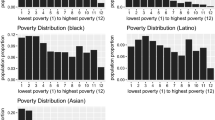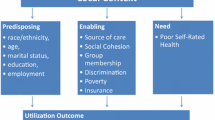Abstract
Background
Cancer screening is effective in reducing the burden of breast, cervical, and colorectal cancers, but not all communities have appropriate access to these services. In this study, we aimed to identify under-resourced communities by assessing the association between the Social Vulnerability Index (SVI) with screening rates for breast, cervical, and colorectal cancers in ZIP-code tabulation areas (ZCTAs) in Rhode Island.
Methods
This study leveraged deidentified health insurance claims data from HealthFacts RI, the state’s all-payer claims database, to calculate screening rates for breast, cervical, and colorectal cancers using Healthcare Effectiveness Data and Information Set measures. We used spatial autoregressive Tobit models to assess the association between the SVI, its four domains, and its 15 component variables with screening rates in 2019, accounting for spatial dependencies.
Results
In 2019, 73.2, 65.0, and 66.1% of eligible individuals were screened for breast, cervical, and colorectal cancer, respectively. For every 1-unit increase in the SVI, screening rates for breast and colorectal cancer were lower by 0.07% (95% CI 0.01–0.08%) and 0.08% (95% CI 0.02–0.15%), respectively. With higher scores on the SVI’s socioeconomic domain, screening rates for all three types of cancers were lower.
Conclusion
The SVI, especially its socioeconomic domain, is a useful tool for identifying areas that are under-served by current efforts to expand access to screening for breast, cervical, and colorectal cancer. These areas should be prioritized for new place-based partnerships that address barriers to screening at the individual and community level.




Similar content being viewed by others
Data availability
The US Census and American Community Survey are both publicly available at www.census.gov. The Rhode Island All Payers Claims Database used in this study is managed by the Rhode Island Department of Health and can be requested at www.health.ri.gov/data/healthfactsri/.
References
Cancer 2022 [cited 2023 Apr 21]. Available from: https://www.cdc.gov/chronicdisease/resources/publications/factsheets/cancer.htm
Siegel RL, Miller KD, Wagle NS, Jemal A (2023) Cancer statistics, 2023. CA Cancer J Clin 73(1):17–48
CDCBreastCancer (2023) Screening tests. Centers for disease control and prevention. [cited 2023 Apr 21] Available from: https://www.cdc.gov/cancer/dcpc/prevention/screening.htm
Recommendation topics [cited 2023 Apr 21]. Available from: https://www.uspreventiveservicestaskforce.org/uspstf/recommendation-topics
Weisband YL, Torres L, Paltiel O, Sagy YW, Calderon-Margalit R, Manor O (2021) Socioeconomic disparity trends in cancer screening among women after introduction of national quality indicators. Ann Fam Med 19(5):396–404
Tabaac AR, Sutter ME, Wall CSJ, Baker KE (2018) Gender identity disparities in cancer screening behaviors. Am J Prev Med 54(3):385–393
Jun J, Nan X (2018) Determinants of cancer screening disparities among Asian Americans: a systematic review of public health surveys. J Cancer Educ 33(4):757–768
The social-ecological model: A framework for prevention (2022) [cited 2023 Mar 27]. Available from: https://www.cdc.gov/violenceprevention/about/social-ecologicalmodel.html
Rutter CM, Knudsen AB, Lin JS, Bouskill KE (2021) Black and White differences in colorectal cancer screening and screening outcomes: a narrative review. Cancer Epidemiol Biomarkers Prev 30(1):3–12
Gehlert S, Hudson D, Sacks T (2021) A critical theoretical approach to cancer disparities: breast cancer and the social determinants of health. Front Public Health 9:674736
Downs LS, Smith JS, Scarinci I, Flowers L, Parham G (2008) The disparity of cervical cancer in diverse populations. Gynecol Oncol 109(2 Suppl):S22-30
Coughlin SS, Blumenthal DS, Seay SJ, Smith SA (2016) Toward the elimination of colorectal cancer disparities among African Americans. J Racial Ethn Health Disparities 3(4):555–564
Breast cancer death rates are highest for Black women—again (2022) [cited 2023 Apr 21]. Available from: https://www.cancer.org/latest-news/breast-cancer-death-rates-are-highest-for-black-women-again.html
Iwuji K, Hyde B, Uke N (2021) Colorectal cancer disparities and African Americans: is it time to narrow the gap? The Southwest Respir Crit Care Chron 9(40):27–30
Chan CK, Aimagambetova G, Ukybassova T, Kongrtay K, Azizan A (2019) Human papillomavirus infection and cervical cancer: epidemiology, screening, and vaccination-review of current perspectives. J Oncol 2019:3257939
Buskwofie A, David-West G, Clare CA (2020) A review of cervical cancer: incidence and disparities. J Natl Med Assoc 112(2):229–232
All-payer claims databases [cited 2023 Mar 27]. Available from: https://www.ahrq.gov/data/apcd/index.html
HealthFacts RI Database [cited 2023 Mar 27]. Available from: https://health.ri.gov/data/healthfactsri/
About NCQA (2018) [cited 2023 Mar 27]. Available from: https://www.ncqa.org/about-ncqa/
HEDIS measures and technical resources (2022) NCQA [cited 2023 Mar 27]. Available from: https://www.ncqa.org/hedis/measures/
da Costa Vieira RA, Biller G, Uemura G, Ruiz CA, Curado MP (2017) Breast cancer screening in developing countries. Clinics 72:244–253
Rerucha CM, Caro R, Wheeler V (2018) Cervical cancer screening. Am Fam Physician 97(7):441–448
Colorectal cancer screening (2018) NCQA [cited 2023 Mar 27]. Available from: https://www.ncqa.org/hedis/measures/colorectal-cancer-screening/
Flanagan BE, Gregory EW, Hallisey EJ, Heitgerd JL, Lewis B (2011) A social vulnerability index for disaster management. J Homel Secur Emerg Mana. https://doi.org/10.2202/1547-7355.1792
Tran T, Rousseau MA, Farris DP, Bauer C, Nelson KC, Doan HQ (2023) The social vulnerability index as a risk stratification tool for health disparity research in cancer patients: a scoping review. Cancer Causes Control 34(5):407–420
Bauer C, Zhang K, Xiao Q, Lu J, Hong YR, Suk R (2022) County-level social vulnerability and breast, cervical, and colorectal cancer screening rates in the US, 2018. JAMA Netw Open 5(9):e2233429
Azuonye C (2019) The impact of access, socioeconomic status, and education, on breast cancer screening in Boston, MA. Walden University [cited 2023 Mar 27]. Available from: https://scholarworks.waldenu.edu/dissertations/7911/
Koç H, O’Donnell O, Van Ourti T (2018) What explains education disparities in screening mammography in the United States? A comparison with The Netherlands. Int J Environ Res Public Health. https://doi.org/10.3390/ijerph15091961
Santiago-Rodríguez EJ, Rivadeneira NA, Torres JM, Sarkar U, Hiatt RA (2022) Socioeconomic status and colorectal cancer screening behaviors in a vulnerable multiethnic population. Ethn Health 27(4):980–996
Calo WA (2014) Place matters: associations between contextual characteristics and health. The Texas Medical Center Library [cited 2023 Apr 21]. Available from: https://digitalcommons.library.tmc.edu/dissertations/AAI3643582/
Kurani SS, McCoy RG, Lampman MA, Doubeni CA, Finney Rutten LJ, Inselman JW et al (2020) Association of neighborhood measures of social determinants of health with breast, cervical, and colorectal cancer screening rates in the US midwest. JAMA Netw Open 3(3):e200618
Funding
No funding was received.
Author information
Authors and Affiliations
Contributions
JH contributed to the conceptualization, formal analysis, methodology, software, visualization, and writing of the original draft of this paper. PR contributed to the data curation and reviewing and editing of this paper. EL contributed to the data curation for this paper. WG contributed to developing the methodology, reviewing and editing, and supervising this process.
Corresponding author
Ethics declarations
Competing interest
All authors have no conflicts of interests to declare.
Ethical approval
Deemed exempt by local institutional review board.
Additional information
Publisher's Note
Springer Nature remains neutral with regard to jurisdictional claims in published maps and institutional affiliations.
Rights and permissions
Springer Nature or its licensor (e.g. a society or other partner) holds exclusive rights to this article under a publishing agreement with the author(s) or other rightsholder(s); author self-archiving of the accepted manuscript version of this article is solely governed by the terms of such publishing agreement and applicable law.
About this article
Cite this article
Hwang, J., Risica, P.M., Lamy, E. et al. Association between the social vulnerability index and breast, cervical, and colorectal cancer screening rates in Rhode Island. Cancer Causes Control (2024). https://doi.org/10.1007/s10552-024-01872-6
Received:
Accepted:
Published:
DOI: https://doi.org/10.1007/s10552-024-01872-6




